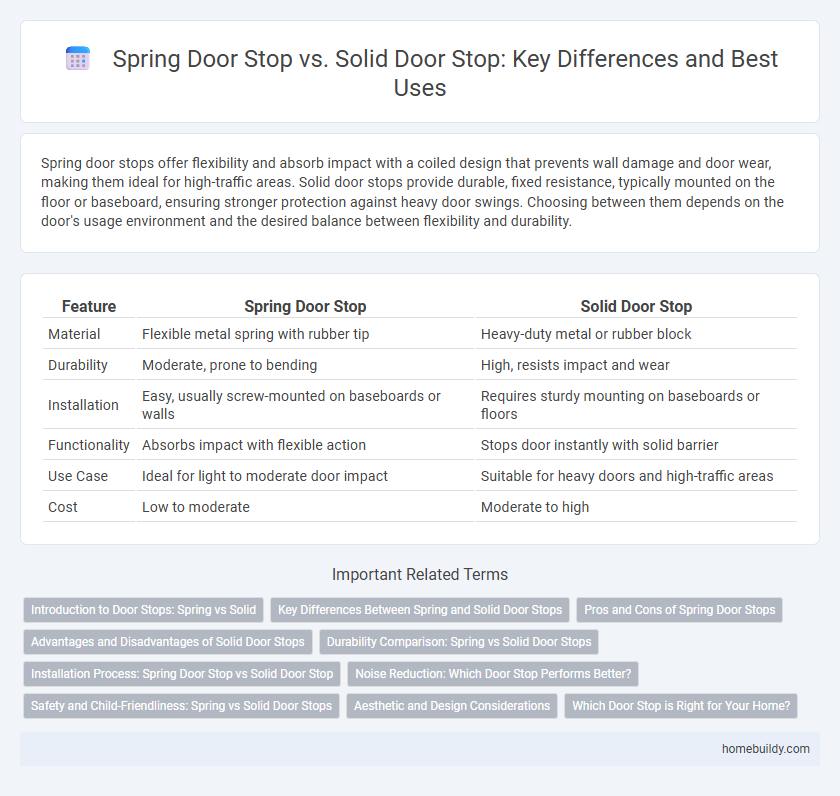Spring door stops offer flexibility and absorb impact with a coiled design that prevents wall damage and door wear, making them ideal for high-traffic areas. Solid door stops provide durable, fixed resistance, typically mounted on the floor or baseboard, ensuring stronger protection against heavy door swings. Choosing between them depends on the door's usage environment and the desired balance between flexibility and durability.
Table of Comparison
| Feature | Spring Door Stop | Solid Door Stop |
|---|---|---|
| Material | Flexible metal spring with rubber tip | Heavy-duty metal or rubber block |
| Durability | Moderate, prone to bending | High, resists impact and wear |
| Installation | Easy, usually screw-mounted on baseboards or walls | Requires sturdy mounting on baseboards or floors |
| Functionality | Absorbs impact with flexible action | Stops door instantly with solid barrier |
| Use Case | Ideal for light to moderate door impact | Suitable for heavy doors and high-traffic areas |
| Cost | Low to moderate | Moderate to high |
Introduction to Door Stops: Spring vs Solid
Spring door stops offer flexible cushioning by absorbing impact through a coiled design, preventing damage to walls and doors. Solid door stops provide a rigid barrier, often mounted on floors or walls, ensuring sturdy resistance against door swings. Choosing between spring and solid door stops depends on application needs, durability, and aesthetic preferences.
Key Differences Between Spring and Solid Door Stops
Spring door stops feature a flexible coil design that absorbs impact, reducing damage to doors and walls, while solid door stops are rigid and provide stable, fixed resistance to door movement. Spring stops are typically easier to install and better suited for high-traffic areas due to their shock-absorbing properties, whereas solid stops offer greater durability and are ideal for heavy doors requiring firm holding positions. The choice between spring and solid door stops depends on specific needs for flexibility, durability, and the frequency of door usage.
Pros and Cons of Spring Door Stops
Spring door stops offer flexibility by absorbing impact and reducing damage to walls and doors, making them ideal for high-traffic areas. However, their exposed metal coil design can be less durable and prone to bending or breaking compared to solid door stops, which provide robust and long-lasting protection. While spring door stops are easier to install and less noticeable, they require occasional maintenance to ensure continued effectiveness.
Advantages and Disadvantages of Solid Door Stops
Solid door stops provide sturdy and reliable protection against wall damage, offering long-lasting durability and requiring minimal maintenance. Their fixed design prevents door movement effectively but may cause potential marks on the door or floor due to impact. Unlike spring door stops, solid stops lack flexibility, which can result in harsher contact and increased wear over time.
Durability Comparison: Spring vs Solid Door Stops
Spring door stops offer flexibility with their coiled design, absorbing impact to prevent damage but are prone to wear and metal fatigue over time. Solid door stops, typically made from sturdy materials like rubber or metal, provide long-lasting durability and resistance to frequent use without deforming or breaking. For high-traffic areas, solid door stops maintain structural integrity better than spring door stops, ensuring prolonged protection for walls and doors.
Installation Process: Spring Door Stop vs Solid Door Stop
Spring door stops install with a simple screw into baseboards or doors, requiring minimal tools and effort, making them ideal for quick and easy setups. Solid door stops typically demand more precise placement and sturdier fixed installation, often involving drilling into walls or floors for enhanced durability. The installation process for solid stops is more permanent, offering stronger protection against door damage compared to spring stops.
Noise Reduction: Which Door Stop Performs Better?
Spring door stops provide effective noise reduction by absorbing impact and preventing loud bangs when the door hits the wall, using flexible coils to dampen sound vibrations. Solid door stops, typically made of rubber or metal, offer durable protection but may transmit more noise upon impact due to their rigid structure. For optimal noise reduction in high-traffic areas, spring door stops generally outperform solid door stops by minimizing the sound of door closure.
Safety and Child-Friendliness: Spring vs Solid Door Stops
Spring door stops offer enhanced safety by flexibly absorbing impact, reducing the risk of finger injuries for children, while solid door stops provide a rigid barrier that effectively prevents door slamming but may pose a higher risk of injury on contact. Child-friendly environments benefit from spring door stops due to their softer design and minimized pinch hazards. In contrast, solid door stops excel in durability and strength but require careful placement to ensure they do not create safety concerns for young children.
Aesthetic and Design Considerations
Spring door stops offer a flexible, unobtrusive design that blends seamlessly with modern interiors, providing a minimalist aesthetic ideal for contemporary spaces. Solid door stops, typically made from sturdy materials like metal or rubber, present a more prominent and durable presence, often chosen for their classic or industrial look. Selecting between the two depends on the desired visual impact and functional requirements, balancing subtlety with robustness in door hardware styling.
Which Door Stop is Right for Your Home?
Spring door stops offer flexibility and durability by absorbing impact and preventing door damage, making them ideal for high-traffic areas or homes with children and pets. Solid door stops provide a sturdy, fixed barrier that effectively protects walls and furniture from door swings, best suited for spaces requiring strong, reliable protection. Choosing the right door stop depends on your home's traffic patterns, aesthetic preferences, and the level of door impact prevention needed.
Spring Door Stop vs Solid Door Stop Infographic

 homebuildy.com
homebuildy.com